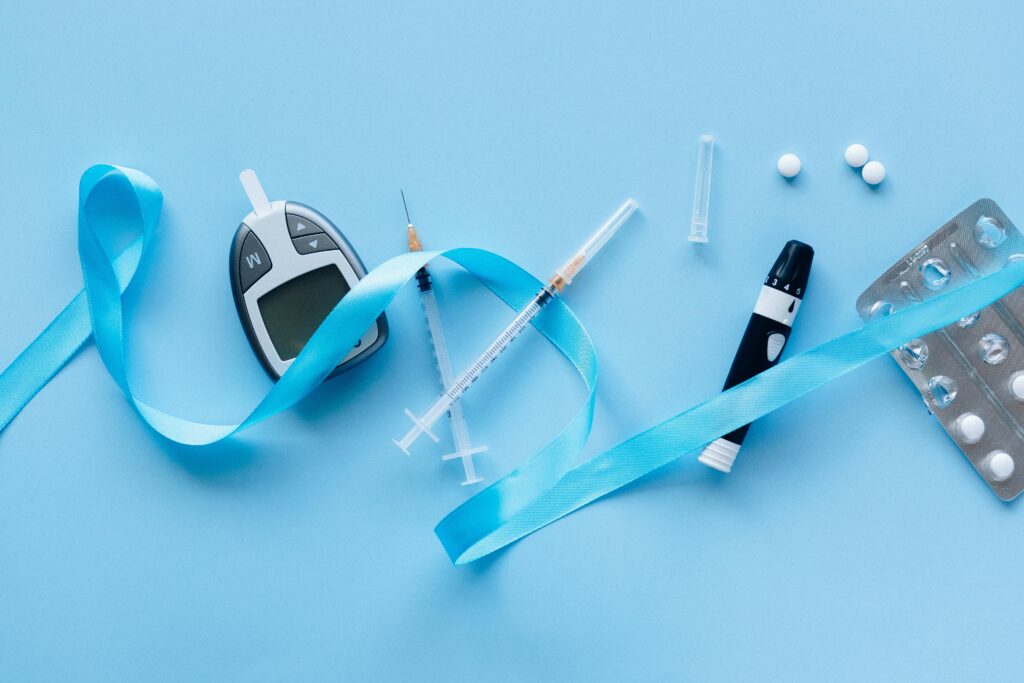A healthy diet is essential for everyone, but it is especially important for people with diabetes. Diabetes is a chronic condition that affects how your body processes glucose, the main source of energy for your cells. Managing diabetes requires a combination of medication, lifestyle changes, and a healthy diet. In this article, we will explore the fundamentals of a healthy diet for diabetes, including dietary recommendations, meal planning strategies, and special considerations.

Understanding diabetes is the first step in developing a healthy diet plan. Diabetes is a disease that affects the way your body processes glucose, a type of sugar that is found in many foods. People with diabetes have high blood sugar levels because their bodies either do not produce enough insulin or do not use insulin effectively. Insulin is a hormone that helps your body use glucose for energy. Without enough insulin, glucose builds up in your bloodstream, leading to a range of health problems.
Key Takeaways
- A healthy diet is essential for people with diabetes.
- Understanding diabetes is the first step in developing a healthy diet plan.
- A healthy diet for diabetes includes a variety of nutrient-dense foods, portion control, and regular monitoring of blood sugar levels.
Understanding Diabetes

Diabetes is a chronic condition that affects how the body processes blood sugar (glucose). Glucose is an important source of energy for the body’s cells, and insulin, a hormone produced by the pancreas, helps regulate glucose levels in the blood. In people with diabetes, the body either doesn’t produce enough insulin or can’t use insulin effectively, leading to high blood sugar levels.
Types of Diabetes
There are three main types of diabetes: type 1, type 2, and gestational diabetes. Type 1 diabetes is an autoimmune disease in which the body’s immune system attacks and destroys the cells in the pancreas that produce insulin. Type 2 diabetes is the most common type of diabetes and occurs when the body becomes resistant to insulin or doesn’t produce enough insulin to maintain normal blood sugar levels. Gestational diabetes occurs during pregnancy and usually resolves after delivery, but can increase the risk of type 2 diabetes later in life.
How Diabetes Affects the Body
Over time, high blood sugar levels can damage blood vessels and nerves throughout the body, leading to a variety of complications. These complications can include heart disease, stroke, kidney disease, nerve damage, and eye damage. It is important for people with diabetes to manage their blood sugar levels through a combination of medication, healthy eating, and regular physical activity to reduce the risk of these complications.
Maintaining a healthy diet is an important part of managing diabetes. A balanced diet that includes plenty of fruits, vegetables, whole grains, lean proteins, and healthy fats can help keep blood sugar levels stable and reduce the risk of complications. It is also important to limit processed foods, sugary drinks, and foods high in saturated and trans fats, which can increase the risk of heart disease and other complications.
Fundamentals of a Healthy Diet

Maintaining a healthy diet is essential for managing diabetes. A healthy diet helps regulate blood sugar levels, maintain a healthy weight, and reduce the risk of complications associated with diabetes. The fundamentals of a healthy diet for diabetes include macronutrient balance, glycemic index, and load.
Macronutrient Balance
A balanced diet for diabetes includes a proper balance of macronutrients, which are carbohydrates, proteins, and fats. Carbohydrates are important for providing energy, but they can also cause blood sugar levels to rise quickly. Proteins help build and repair tissues, while fats provide energy and help the body absorb vitamins.
A balanced diet for diabetes should include a variety of nutrient-dense foods that are rich in vitamins, minerals, and fiber. Foods such as whole grains, fruits, vegetables, lean proteins, and healthy fats are all important components of a healthy diet for diabetes.
Glycemic Index and Load
The glycemic index (GI) is a measure of how quickly a food raises blood sugar levels. Foods with a high GI value raise blood sugar levels quickly, while foods with a low GI value raise blood sugar levels more slowly. The glycemic load (GL) takes into account both the GI value and the amount of carbohydrates in a food.
Foods with a high GI and GL value should be limited in a healthy diet for diabetes. These foods include processed foods, sugary drinks, white bread, and white rice. Foods with a low GI and GL value are preferred, such as whole grains, fruits, vegetables, and legumes.
In conclusion, a healthy diet for diabetes should include a proper balance of macronutrients, nutrient-dense foods, and foods with a low GI and GL value. By following these fundamentals, individuals with diabetes can better manage their blood sugar levels and reduce the risk of complications associated with diabetes.
Dietary Recommendations

People with diabetes need to be mindful of what they eat to keep their blood sugar levels in check. A healthy diet can help manage diabetes and prevent complications. Here are some dietary recommendations for people with diabetes:
Fruits and Vegetables
Fruits and vegetables are an essential part of a healthy diet for everyone, especially for people with diabetes. They provide essential vitamins, minerals, and fiber. The American Diabetes Association recommends that people with diabetes should consume at least three servings of non-starchy vegetables per day. Some examples of non-starchy vegetables include broccoli, spinach, and carrots. Fruits should also be consumed in moderation as they contain natural sugars that can impact blood sugar levels.
Whole Grains and Fiber
Whole grains and fiber are also important for people with diabetes. They can help regulate blood sugar levels and improve heart health. Whole grains include foods like brown rice, quinoa, and whole wheat bread. The American Diabetes Association recommends that people with diabetes should consume at least 25 grams of fiber per day for women and 38 grams per day for men.
Lean Proteins
Lean proteins are an important part of a healthy diet for people with diabetes. They can help regulate blood sugar levels and keep you feeling full for longer. Some examples of lean proteins include chicken, fish, and tofu. It is important to choose lean cuts of meat and to avoid processed meats like bacon and sausage, which can be high in saturated fat.
Healthy Fats
Healthy fats are an essential part of a healthy diet for people with diabetes. They can help improve heart health and regulate blood sugar levels. Some examples of healthy fats include avocados, nuts, and olive oil. It is important to consume these fats in moderation as they are high in calories.
By following these dietary recommendations, people with diabetes can manage their condition and improve their overall health.
Meal Planning Strategies

Meal planning is an essential part of managing diabetes. It helps regulate blood sugar levels and ensures that the body gets the nutrients it needs. Here are some meal planning strategies that can help:
Portion Control
Portion control is crucial for people with diabetes. Eating too much can cause blood sugar levels to spike, while eating too little can cause them to drop too low. A good way to control portions is to use measuring cups and spoons, or a food scale. Another helpful tool is the “plate method,” which involves dividing the plate into sections for different food groups. For example, half the plate should be filled with non-starchy vegetables, a quarter with lean protein, and a quarter with whole grains or starchy vegetables.
Carbohydrate Counting
Carbohydrate counting is another useful strategy for managing diabetes. Carbohydrates have the most significant effect on blood sugar levels, so it’s important to keep track of how many carbs are being consumed. A registered dietitian can help determine the appropriate amount of carbs for an individual’s needs. Carbohydrate counting involves reading food labels and using carbohydrate counting apps or charts to keep track of carb intake.
Reading Food Labels
Reading food labels is essential for people with diabetes. It helps them determine the nutritional value of the food they are eating, including the number of carbs, fiber, and sugar. When reading food labels, it’s important to pay attention to serving size, as well as the total number of carbs and sugar. It’s also important to look for foods that are high in fiber and low in sugar.
By following these meal planning strategies, people with diabetes can manage their blood sugar levels and maintain a healthy diet.
Monitoring and Adjusting Your Diet

Blood Sugar Monitoring
It is essential for people with diabetes to monitor their blood sugar levels regularly. The frequency of monitoring can vary depending on individual needs, but it is recommended to check blood sugar levels at least once a day. Blood sugar monitoring helps to identify patterns and trends in blood sugar levels that can be used to adjust the diet and medication.
There are different ways to monitor blood sugar levels, including using a blood glucose meter, continuous glucose monitoring system (CGM), and flash glucose monitoring system. It is important to follow the manufacturer’s instructions when using any of these devices and to keep a record of the results.
Dietary Adjustments Based on Blood Sugar
Based on the blood sugar monitoring results, dietary adjustments can be made to help manage diabetes. If blood sugar levels are consistently high, it may be necessary to adjust the diet to reduce the intake of carbohydrates, especially simple sugars. This can be achieved by increasing the intake of non-starchy vegetables, lean proteins, and healthy fats.
On the other hand, if blood sugar levels are consistently low, it may be necessary to adjust the diet to include more carbohydrates. This can be achieved by adding more whole grains, fruits, and starchy vegetables to the diet.
It is important to work with a registered dietitian or healthcare provider to develop an individualized meal plan that meets the individual’s needs and goals. Making dietary adjustments based on blood sugar monitoring can help improve diabetes management and prevent complications.
Special Considerations

Alcohol and Sweeteners
Individuals with diabetes should limit their alcohol intake to moderate levels. Drinking alcohol can cause hypoglycemia, or low blood sugar, especially if consumed on an empty stomach. Additionally, alcohol can interfere with the liver’s ability to produce glucose, leading to low blood sugar levels.
When it comes to sweeteners, individuals with diabetes should limit their intake of added sugars and opt for natural sweeteners such as stevia or monk fruit. Artificial sweeteners such as aspartame and saccharin are also safe for people with diabetes to consume in moderation.
Eating Out and Social Events
Eating out and attending social events can be challenging for individuals with diabetes, but it is possible to make healthy choices. When dining out, individuals with diabetes should look for menu items that are grilled, baked, or broiled instead of fried. They should also avoid dishes that are high in fat, sodium, and added sugars.
It is important for individuals with diabetes to pay attention to portion sizes and to avoid overeating. They should also limit their intake of alcoholic beverages and sugary drinks. When attending social events, individuals with diabetes should bring a healthy dish to share and focus on socializing rather than food.
Overall, individuals with diabetes can maintain a healthy diet by making smart choices and being mindful of their food intake. By following a balanced diet and staying active, individuals with diabetes can manage their blood sugar levels and improve their overall health.
Support and Resources

Working with a Dietitian
Working with a registered dietitian can help individuals with diabetes manage their diet and improve their overall health. Dietitians can provide personalized meal plans that take into account an individual’s food preferences, lifestyle, and cultural background. They can also help individuals learn how to read food labels, count carbohydrates, and make healthy food choices when eating out.
Diabetes Education Programs
Diabetes education programs can provide valuable support and resources for individuals with diabetes. These programs offer education and training on a variety of topics related to diabetes management, including healthy eating, physical activity, blood glucose monitoring, and medication management. Many programs also offer one-on-one counseling with a diabetes educator, as well as group classes and support groups.
Some diabetes education programs are covered by insurance, while others may require out-of-pocket expenses. Individuals with diabetes should check with their insurance provider to see if diabetes education programs are covered under their plan. They can also ask their healthcare provider for recommendations on local programs.
Overall, working with a dietitian and participating in diabetes education programs can provide valuable support and resources for individuals with diabetes. These resources can help individuals manage their diabetes, improve their health, and reduce their risk of complications.
Frequently Asked Questions

What are the optimal food choices for managing type 2 diabetes?
People with type 2 diabetes should focus on eating foods that are high in nutrients and low in calories, saturated fats, and added sugars. This includes a variety of non-starchy vegetables, whole grains, lean proteins, and healthy fats such as nuts and seeds. It is also important to limit processed foods and sugary drinks.
Which foods should be avoided to maintain healthy blood sugar levels?
Foods that are high in added sugars, saturated fats, and refined carbohydrates should be avoided as they can cause blood sugar levels to spike. This includes sugary drinks, candy, baked goods, white bread, and pasta. It is also important to limit alcohol consumption as it can affect blood sugar levels.
How can a diabetic construct a balanced daily meal plan?
A balanced daily meal plan for a diabetic should include a variety of non-starchy vegetables, whole grains, lean proteins, and healthy fats. It is important to also consider portion sizes and to spread meals and snacks throughout the day to help maintain healthy blood sugar levels. Consulting with a registered dietitian can also be helpful in creating a personalized meal plan.
What are the top recommended snacks for people with diabetes?
Healthy snacks for people with diabetes include raw veggies with hummus, apple slices with almond butter, hard-boiled eggs, and Greek yogurt with berries. It is important to choose snacks that are high in fiber and protein and low in added sugars.
Can you provide a sample diet sheet for managing type 2 diabetes?
A sample diet sheet for managing type 2 diabetes may include:
- Breakfast: Oatmeal with berries and nuts
- Snack: Carrots with hummus
- Lunch: Grilled chicken salad with mixed greens and vinaigrette dressing
- Snack: Apple slices with almond butter
- Dinner: Baked salmon with roasted vegetables
- Snack: Greek yogurt with berries
What dietary strategies are most effective for beginners with diabetes?
For beginners with diabetes, it is important to focus on making small changes to their diet over time. This can include increasing their intake of non-starchy vegetables, choosing whole grains over refined carbohydrates, and limiting processed foods and sugary drinks. It is also important to work with a healthcare provider to monitor blood sugar levels and adjust dietary strategies as needed.
Read Also; Managing Diabetes: Overcoming Challenges and Regaining Control
Thinking of a supplement to control diabetes? ”See here what we recommend!”



